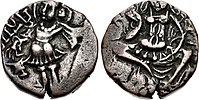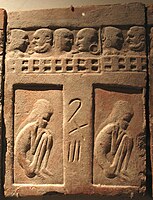Gonanda dynasty (II)
Gonanda dynasty of Kashmir (Gonanda dynasty II) | |||||||||||||
|---|---|---|---|---|---|---|---|---|---|---|---|---|---|
| c. 25 CE–c. 561 CE | |||||||||||||
Purported location of the Gonanda dynasty and neighboring polities circa 500 CE | |||||||||||||
| Common languages | Sanskrit | ||||||||||||
| Religion | Hinduism | ||||||||||||
| Government | Monarchy | ||||||||||||
| Historical era | Pre Classical India | ||||||||||||
• Established | c. 25 CE | ||||||||||||
• Disestablished | c. 561 CE | ||||||||||||
| |||||||||||||
The Second Gonanda dynasty, or Restored Gonanda dynasty, was according to the Medieval author Kalhana, the last dynasty of Gonanda line of rulers of Kashmir. According to Kalhana's Rajatarangini, this dynasty was followed by the Karkoṭa dynasty of Kashmir.[1][2]
Description[]
According to Kalhana's third book of the Rajatarangini, the last Gonanda dynasty of Kashmir ruled for about 590 years, until the establishment of the Karkota dynasty.[3] However the chronology is widely deemed to be faulty and on cross-vetting with coins and inscriptions from outside Kashmir, the names of some of the Gonanda rulers are found to roughly correspond with the Alchon Huns, who ruled hundreds of years later than the time-frame assigned by Kalhana.[4][5] In Kalhana's narrative, names of some rulers are reshuffled and/or repeated multiple times across the first and third book, some stories are retrofitted and recycled, some reigns are impossibly long, and some rulers are telescoped into the past.[6]
According to a roughly literal reading of the Rajatarangini, the first ruler of the succeeding Karkota dynasty, named Durlabhavardhana, belonged to a low caste and was employed by Baladitya, the last ruler of the Gonanda dynasty.[7] Baladitya (apparently) had no male heir but a daughter Anaṅgalekhā and did not wish his territory to be annexed by in-laws.[7][3] To avert such a possibility he married her to Durlabhavardhana, who had no royal lineage.[3] However, after Baladitya's death, Durlabhavardhana ascended to the throne with help from a minister, and claimed descent from the mythical Naga king Karkotaka, establishing the Karkota Dynasty.[8][9][10][11][3] This view is accepted by Witzel[12] and Devika Rangachari.
The Rajatarangini also associates these kings with the Indian ruler "Harsha", probably Harshavardhana.[13]
Coinage[]

Obverse: Shiva Pashupati ("Lord of the Beasts"), making a mudra gesture with right hand and holding filleted trident; behind, a lioness or tiger. Trace of legend Meghana... in Brahmi.
Reverse: Goddess seated facing on lotus, holding lotus in both hand, Kidara monogram to left, Jaya in Brahmi to right. Circa 7th century CE, Kashmir.[14]
Several coins have been found in the region of Kashmir and around, which bear names consistent with the names of several of the Gonanda rulers listed by Kalhana: Śrī Meghamah (probably king Meghavahana of the Rajatarangini), Śrī Pravarasenah (King Pravarasena), Śrī Tuysīna (probably King Tunjina), and Śrī Toramaņa (the Kashmir ruler named Toramana).[14] Śrī Toramaņa has the same name as the Alchon Hun ruler Toramana, but would be a different, later, ruler.[15] These coins are quite rare, made of copper, silver, or debased gold, and generally follow Kushan and Kidarite designs.[14]
The coins are beautifully minted, and are comparable in quality to the best coins of the Kushans or the Guptas.[14] The style is comparable to the style of the sculptures found in Kashmir and dated to the 6th-9th centuries CE.[14]
The coins show on the obverse a standing Shiva figures, variously accompanied by animals or Gana attendants, with the name of the king in the Brahmi script.[14] On the reverse, the Goddess Ardoxsho or Sri Lakshmi appears seated, with a Kidara monogram to left, and Jaya in Brahmi to right.[14] "Kidara" is the name of another Hunnic ruler, founder of the Kidarites, which further reinforces the connection of the Gonandas with the Hunas.[15]
Late Kushan and Kidarite coins were also found in the hoards containing the Gonanda coins, especially coins of the late Kushan Empire ruler Shaka.[14]
Overall, the coinage suggests that these rulers of Kashmir were descendants of the Huna kings, who had ruled northwestern India from the 4th to the 6th century CE.[15]
Various degraded imitations of these coins were made, until the rule of the Kashmiri King Avanti Varman (855-883 CE).[14]

Coinage of Pravarasena, supposed founder of Srinagar. Obverse: Standing Shiva with two figures seated below. Name "Pravarasena". Reverse: goddess seated on a lion. Legend "Kidāra". Circa 6th-early 7th century CE.[14]

Coin in the name of Sri Tujina. Circa 7th century CE, Kashmir.[14]

Coin in the name of Śrī Toramaņa (the Kashmir ruler named Toramana).[14]
Genealogy[]
| Ruler | Reign[16] | Ascension year per Kalhana |
Notes |
|---|---|---|---|
| Meghavahana | 34 years | 25 CE | Meghavahana was the son of Yudhisthira I's great grandson, who had been granted asylum by Gopaditya, the king of Gandhara. Meghavahana had been selected the husband of a Vaishnavite princess at a Swayamvara in another kingdom. The ministers of Kashmir brought him to Kashmir after Sandhimati proved to be an unwilling king. Meghavahana banned animal slaughter and compensated those who earned their living through hunting. He patrnozed Brahmins, and set up a monastery. His queens built Buddhist viharas and monasteries. He subdued kings in regions as far as Sinhala Kingdom, forcing them to abandon animal slaughter. |
| Shreshtasena (Pravarasena I / Tungjina II) | 30 years | 59 CE | Son of Meghavahana |
| Hiranya | 30 years, 2 months | 89 CE | Son of Shreshtasena, assisted by his brother and co-regent Toramana. The king imprisoned Toramana, when the latter stuck royal coins in his own name. Toramana's son Pravarasena, who had been brought up in secrecy by his mother Anjana, freed him. Hiranya died childless. Several coins of a king named Toramana have been found in the Kashmir region. This king is identified by some with Huna ruler Toramana, although his successor Mihirakula is placed much earlier by Kalhana.[17] |
| Toramana | Son of Pravarasena I, Vice-king of Hiranya.[14] | ||
| Matrigupta | 4 years, 9 months, 1 day | 120 CE | According to Kalhana, the emperor Vikramditya (alias Harsha) of Ujjayini defeated the Shakas, and made his friend and poet Matrigupta the ruler of Kashmir. After Vikramaditya's death, Matrigupta abdicated the throne in favour of Pravarasena. According to D. C. Sircar, Kalhana has confused the legendary Vikramaditya of Ujjain with the Vardhana Emperor Harsha (c. 606-47 CE).[18] The latter is identified with Shiladitya mentioned in Xuanzang's account. However, according to M. A. Stein, Kalhana's Vikramaditya is another Shiladitya mentioned in Xuanzang's account: a king of Malwa around 580 CE.[19] |
| Pravarasena II | 60 years | 125 CE | Historical evidence suggests that a king named Pravarasena ruled Kashmir in the 6th century CE.[17] According to Kalhana, Pravarasena subdued many other kings, in lands as far as Saurashtra. He restored the rule of Vikramaditya's son Pratapshila (alias Shiladitya), who had been expelled from Ujjain by his enemies. Pratapshila agreed to be a vassal of Pravarasena after initial resistance. He founded a city called Pravarapura, which is identified by later historians as the modern city of Srinagar on the basis topographical details.[20] |
| Yudhishthira II | 39 years, 8 months | 185 CE | Son of Pravarasena |
| Narendraditya I (Lakshmana) | 13 years | 206 CE | Son of Yudhishthira II and Padmavati |
| Ranaditya I (Tungjina III) | 300 years | 219 CE | Younger brother of Narendraditya. His queen Ranarambha was an incarnation of Bhramaravasini. The Chola king Ratisena had found her among the waves, during an ocean worship ritual. |
| Vikramaditya | 42 years | 519 CE | Son of Ranaditya |
| Baladitya | 36 years, 8 months | 561 CE | Younger brother of Vikramaditya. He subdued several enemies. An astrologer prophesied that his son-in-law would succeed him as the king. To avoid this outcome, the king married his daughter Anangalekha to Durlabhavardhana, a handsome but non-royal man from Ashvaghama Kayastha caste. |
Art of Kashmir in the 5th-6th century[]

Tile showing a woman carrying a pot, Harwan, Jammu and Kashmir, 5th-6th century CE

Tile with Impressed Figure of Emaciated Ascetics and Couples Behind Balconies, Harwan, Jammu and Kashmir, 5th-6th century CE

Terracotta head from Akhnoor, Kashmir, 6th century CE.

Vishvarupa Vishnu, Jammu and Kashmir, 6th century CE.
See also[]
References[]
- ^ S.R. Bakshi (1997), Kashmir: History and People,p.63
- ^ Nagendra Kr Singh (2000), Buddhism in Kashmir, p.115
- ^ Jump up to: a b c d Stein, Marc Aurel (1900). Kalhana's Rajatarangini: a chronicle of the kings of Kasmir. Westminster: Archibald Constable. pp. 86–97, 136, 142 (Introduction), 120-185 (The Rajatarangini of Kalahana: Fourth Book).
- ^ Siudmak, John (5 April 2013). The Hindu-Buddhist Sculpture of Ancient Kashmir and its Influences. ISBN 978-9004248328.
- ^ Cribb, Joe (2016). "Early Medieval Kashmir Coinage – A New Hoard and An Anomaly". Numismatic Digest. Numismatic Society of Bombay. 40: 98.
- ^ Dezső, Csaba (2020). "X.1.3: The Kashmir Secular Tradition". In Balogh, Daniel (ed.). Hunnic Peoples in Central and South Asia: Sources for their Origin and History. Groningen: Barkhuis. pp. 296–308. ISBN 9789493194014.
- ^ Jump up to: a b Rangachari, Devika (1 April 2002). "Kalhana's Rājataranginī: A Gender Perspective1". The Medieval History Journal. 5 (1): 46, 48. doi:10.1177/097194580200500103. ISSN 0971-9458. S2CID 144377502.
- ^ SEN, TANSEN (2004). "Kaśmīr, Tang China, and Muktāpīḍa Lalitā-Ditya's Ascendancy over the Southern Hindukush Region". Journal of Asian History. 38 (2): 141–162. ISSN 0021-910X. JSTOR 41933381.
- ^ Zutshi, Chitralekha (2019). "Kashmir as Sacred Space". Kashmir. Delhi: Oxford University Press. Aryavarta.
- ^ Pal, Sayantani (2016), "Karkota dynasty of Kashmir", The Encyclopedia of Empire, American Cancer Society, pp. 1–2, doi:10.1002/9781118455074.wbeoe049, ISBN 978-1-118-45507-4, retrieved 18 March 2021
- ^ Witzel, Michael (September 1991). "THE BRAHMINS OF KASHMIR" (PDF). pp. 24–28.
- ^ Witzel, Michael (2016). "Kashmiri Brahmins under the Karkota, Utpala and Lohara Dynasties, 625-1101 CE". In Franco, Eli; Ratié, Isabelle (eds.). Around Abhinavagupta: Aspects of the Intellectual History of Kashmir from the Ninth to the Eleventh Century. Leipziger Studien zu Kultur und Geschichte Süd- und Zentralasiens. Münster, Germany. pp. 609–643. ISBN 978-3-643-90697-7.
- ^ Cribb, Joe. "Early Medieval Kashmir Coinage – A New Hoard and An Anomaly". Numismatic Digest volume 40 (2016): 99.
- ^ Jump up to: a b c d e f g h i j k l m Cribb, Joe. "Early Medieval Kashmir Coinage – A New Hoard and An Anomaly". Numismatic Digest volume 40 (2016).
- ^ Jump up to: a b c Cribb, Joe. "Early Medieval Kashmir Coinage – A New Hoard and An Anomaly". Numismatic Digest volume 40 (2016): 98–99.
- ^ Stein 1979, pp. 133–138.
- ^ Jump up to: a b Stein 1979, pp. 65.
- ^ D. C. Sircar (1969). Ancient Malwa And The Vikramaditya Tradition. Munshiram Manoharlal. p. 111. ISBN 978-8121503488. Archived from the original on 17 June 2016.
- ^ Stein 1979, pp. 66.
- ^ Stein 1989, pp. 439–441.
- Gonanda dynasty
- Kashmiri people
- Kashmir







